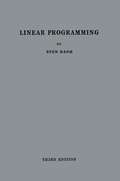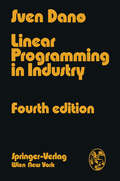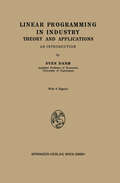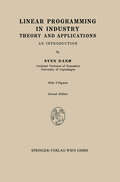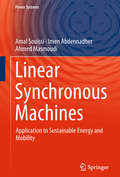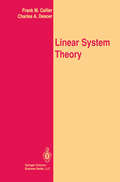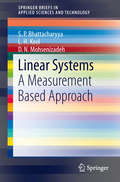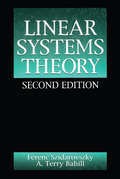- Table View
- List View
Linear Programming and its Applications
by H.A. Eiselt C.-L. SandblomIn the pages of this text readers will find nothing less than a unified treatment of linear programming. Without sacrificing mathematical rigor, the main emphasis of the book is on models and applications. The most important classes of problems are surveyed and presented by means of mathematical formulations, followed by solution methods and a discussion of a variety of "what-if" scenarios. Non-simplex based solution methods and newer developments such as interior point methods are covered.
Linear Programming in Industry: Theory and Applications. An Introduction
by Sven DanoThe present volume is intended to serve a twofold purpose. First, it provides a university text of Linear Programming for students of economics or operations research interested in the theory of production and cost and its practical applications; secondly, it is the author's hope that engineers, business executives, managers, and others responsible for the organization and planning of industrial operations may find the book useful as an introduction to Linear Programming methods and techniques. Despite the different backgrounds of these categories of potential readerR, their respective fields overlap to a considerable extent; both are concerned with economic optimization problems, and the use of Linear Programming to problems of production planning is simply applied theory of production. The non-economist reader may, but should not, pass over Chapter IV in which the linear production model is linked up with the economic theory of production. Without being an advanced text, the book aims at covering enough ground to make the reader capable of detecting, formulating, and solving such linear planning problems as he may encounter within his particular field. No heavy demands are made on the reader's mathematical profi ciency; except for the proofs in the Appendix-which may be skipped if desired-the mathematical exposition is purely elementary, involving only simple linear relations. In the author's experience, the pedagogical advantages of thi;:; approach, as compared with the use of matrix algebra, amply justify the sacrifice of mathematical elegance and typographical simplicity, particularly in explaining the simplex method.
Linear Programming in Industry: Theory and Applications An Introduction
by Sven DanoA. Planning Company Operations: The General Problem At more or less regular intervals, the management of an industrial enter prise is confronted with the problem of planning operations for a coming period. Within this category of management problems falls not only the overall planning of the company's aggregate production but problems of a more limited nature such as, for example, figuring the least-cost combina tion of raw materials for given output or the optimal transportation schedule. Any such problem of production planning is most rationally solved in two stages: (i) The first stage is to determine the feasible alternatives. For example, what alternative production schedules are at all compatible with the given capacity limitations? What combinations of raw materials satisfy the given quality specifications for the products? etc. The data required for solving this part of the problem are largely of a technological nature. (ii) The second is to select from among these alternatives one which is economically optimal: for example, the aggregate production programme which will lead to maximum profit, or the least-cost combination of raw materials. This is where the economist comes in; indeed, any economic problem is concerned with making a choice be.tween alternatives, using some criterion of optimal utilization of resources.
Linear Programming in Industry: Theory and Applications. An Introduction
by Sven DanoThe present volume is intended to serve a twofold purpose. First, it provides a university text of Linear Programming for students of or operations research interested in the theory of production economics and cost and its practical applications; secondly, it is the author's hope that engineers, business executives, managers, and others responsible for the organization and planning of industrial operations may find the book useful as an introduction to Linear Programming methods and techniques. Despite the different backgrounds of these categories of potential readers, their respective fields overlap to a considerable extent; both are concerned with economic optimization problems, and the use of Linear Programming to problems of production planning is simply applied theory of production. The non-economist reader may, but should not, pass over Chapter IV in which the linear production model is linked up with the economic theory of production. Without being an advanced text, the book aims at covering enough ground to make the reader capable of detecting, formulating, and solving such linear planning problems as he may encounter within his particular field. No heavy demands are made on the reader's mathematical profi ciency; except for the proofs in the Appendix-which may be skipped ü desired-the mathematical exposition is purely elementary, involving only simple linear relations. In the author's experience, the pedagogical advantages of this approach, as compared with the use of matrix algebra, amply justify the sacrilice of mathematical elegance and typographical simplicity, particularly in explaining the simplex method.
Linear Programming in Industry: Theory and Applications. An Introduction
by Sven DanoThe present volume is intended to serve a twofold purpose. First, it provides a university text of Linear Programming for students of .economics or operations research interested in the theory of production and cost and its practical applications; secondly, it is the author's hope that engineers, business executives, managers, and others responsible for the organization and planning of industrial operations may find the book useful as an introduction to Linear Programming methods and techniques. Despite the different backgrounds of these categories of potential readerft, their respective fields overlap to a considerable extent; both are concernE:'d with economic optimization problems, and the use of Linear Programming to problems of production planning is simply applied theory of production. The non-economist reader may, but should not, pass over Chapter IV in which the linear production model is linked up with the economic theory of production. Without bE:'ing an advanced text, the book aims at covering enough ground to make the reader capable of detecting, formulating, and solving such linear planning problems as he may encounter within his particular field. No heavy demands are made on the reader's mathematical profi ciency; except for the proofs in the Appendix-which may be skipped if desired-the mathematical exposition is purely elementary, involving only simple linear relations. In the author's experience, the pedagogical advantages of this approach, as compared with the use of matrix algebra, amply justify the sacrifice of mathematical elegance and typographical simplicity, particularly in explaining the simplex method.
Linear Stochastic Systems: A Geometric Approach to Modeling, Estimation and Identification (Series in Contemporary Mathematics #1)
by Anders Lindquist Giorgio PicciThis book presents a treatise on the theory and modeling of second-order stationary processes, including an exposition on selected application areas that are important in the engineering and applied sciences. The foundational issues regarding stationary processes dealt with in the beginning of the book have a long history, starting in the 1940s with the work of Kolmogorov, Wiener, Cramér and his students, in particular Wold, and have since been refined and complemented by many others. Problems concerning the filtering and modeling of stationary random signals and systems have also been addressed and studied, fostered by the advent of modern digital computers, since the fundamental work of R.E. Kalman in the early 1960s. The book offers a unified and logically consistent view of the subject based on simple ideas from Hilbert space geometry and coordinate-free thinking. In this framework, the concepts of stochastic state space and state space modeling, based on the notion of the conditional independence of past and future flows of the relevant signals, are revealed to be fundamentally unifying ideas. The book, based on over 30 years of original research, represents a valuable contribution that will inform the fields of stochastic modeling, estimation, system identification, and time series analysis for decades to come. It also provides the mathematical tools needed to grasp and analyze the structures of algorithms in stochastic systems theory.
Linear Synchronous Machines: Application to Sustainable Energy and Mobility (Power Systems)
by Amal Souissi Imen Abdennadher Ahmed MasmoudiThis book introduces readers to two major sustainable applications of linear synchronous machines: wave energy conversion and magnetic levitation train technology. To do so, it begins with a state-of-the-art review of linear machines, covering induction and synchronous topologies and their applications, with a particular focus on sustainable applications. This is followed by an analysis of the electromagnetic modeling of linear synchronous machines, the goal being to investigate their main features, especially their force production capabilities.
Linear System Theory (Springer Texts in Electrical Engineering)
by Frank M. Callier Charles A. DesoerThis book is the result of our teaching over the years an undergraduate course on Linear Optimal Systems to applied mathematicians and a first-year graduate course on Linear Systems to engineers. The contents of the book bear the strong influence of the great advances in the field and of its enormous literature. However, we made no attempt to have a complete coverage. Our motivation was to write a book on linear systems that covers finite dimensional linear systems, always keeping in mind the main purpose of engineering and applied science, which is to analyze, design, and improve the performance of phy sical systems. Hence we discuss the effect of small nonlinearities, and of perturbations of feedback. It is our on the data; we face robustness issues and discuss the properties hope that the book will be a useful reference for a first-year graduate student. We assume that a typical reader with an engineering background will have gone through the conventional undergraduate single-input single-output linear systems course; an elementary course in control is not indispensable but may be useful for motivation. For readers from a mathematical curriculum we require only familiarity with techniques of linear algebra and of ordinary differential equations.
Linear Systems
by Panos J. Antsaklis Anthony N. Michel"There are three words that characterize this work: thoroughness, completeness and clarity. The authors are congratulated for taking the time to write an excellent linear systems textbook!" —IEEE Transactions on Automatic Control Linear systems theory plays a broad and fundamental role in electrical, mechanical, chemical and aerospace engineering, communications, and signal processing. A thorough introduction to systems theory with emphasis on control is presented in this self-contained textbook, written for a challenging one-semester graduate course. A solutions manual is available to instructors upon adoption of the text. The book’s flexible coverage and self-contained presentation also make it an excellent reference guide or self-study manual. For a treatment of linear systems that focuses primarily on the time-invariant case using streamlined presentation of the material with less formal and more intuitive proofs, please see the authors’ companion book entitled A Linear Systems Primer.
Linear Systems: A Measurement Based Approach (SpringerBriefs in Applied Sciences and Technology)
by S. P. Bhattacharyya L.H. Keel D.N. MohsenizadehThis brief presents recent results obtained on the analysis, synthesis and design of systems described by linear equations. It is well known that linear equations arise in most branches of science and engineering as well as social, biological and economic systems. The novelty of this approach is that no models of the system are assumed to be available, nor are they required. Instead, a few measurements made on the system can be processed strategically to directly extract design values that meet specifications without constructing a model of the system, implicitly or explicitly. These new concepts are illustrated by applying them to linear DC and AC circuits, mechanical, civil and hydraulic systems, signal flow block diagrams and control systems. These applications are preliminary and suggest many open problems. The results presented in this brief are the latest effort in this direction and the authors hope these will lead to attractive alternatives to model-based design of engineering and other systems.
Linear Systems
by Henri Bourlès Godfrey K. KwanLinear systems have all the necessary elements (modeling, identification, analysis and control), from an educational point of view, to help us understand the discipline of automation and apply it efficiently. This book is progressive and organized in such a way that different levels of readership are possible. It is addressed both to beginners and those with a good understanding of automation wishing to enhance their knowledge on the subject. The theory is rigorously developed and illustrated by numerous examples which can be reproduced with the help of appropriate computation software. 60 exercises and their solutions are included to enable the readers to test and enhance their knowledge.
Linear Systems
by Henri Bourlès Godfrey K. KwanLinear systems have all the necessary elements (modeling, identification, analysis and control), from an educational point of view, to help us understand the discipline of automation and apply it efficiently. This book is progressive and organized in such a way that different levels of readership are possible. It is addressed both to beginners and those with a good understanding of automation wishing to enhance their knowledge on the subject. The theory is rigorously developed and illustrated by numerous examples which can be reproduced with the help of appropriate computation software. 60 exercises and their solutions are included to enable the readers to test and enhance their knowledge.
Linear Systems: Optimal and Robust Control
by Alok SinhaBalancing rigorous theory with practical applications, Linear Systems: Optimal and Robust Control explains the concepts behind linear systems, optimal control, and robust control and illustrates these concepts with concrete examples and problems. Developed as a two-course book, this self-contained text first discusses linear systems, incl
Linear Systems: Non-Fragile Control and Filtering
by Guang-Hong Yang Xiang-Gui Guo Wei-Wei Che Wei GuanLinear Systems: Non-Fragile Control and Filtering presents the latest research results and a systematic approach to designing non-fragile controllers and filters for linear systems. The authors combine the algebraic Riccati technique, the linear matrix inequality (LMI) technique, and the sensitivity analysis method to establish a set of new non-fragile (insensitive) control methods. This proposed method can optimize the closed-loop system performance and make the designed controllers or filters tolerant of coefficient variations in controller or filter gain matrices. A Systematic Approach to Designing Non-Fragile Controllers and Filters for Linear Systems The text begins with developments and main research methods in non-fragile control. It then systematically presents novel methods for non-fragile control and filtering of linear systems with respect to additive/multiplicative controller/filter gain uncertainties. The book introduces the algebraic Riccati equation technique to solve additive/multiplicative norm-bounded controller/filter gain uncertainty, and proposes a structured vertex separator to deal with the numerical problem resulting from interval-bounded coefficient variations. It also explains how to design insensitive controllers and filters in the framework of coefficient sensitivity theory. Throughout, the book includes numerical examples to demonstrate the effectiveness of the proposed design methods. More Effective Design Methods for Non-Fragile Controllers and Filters The design and analysis tools described will help readers to better understand and analyze parameter uncertainties and to design more effective non-fragile controllers and filters. Providing a coherent approach, this book is a valuable reference for researchers, graduate students, and anyone who wants to explore the area of non-fragile control and filtering.
Linear Systems: Non-Fragile Control and Filtering
by Guang-Hong Yang Xiang-Gui Guo Wei-Wei Che Wei GuanLinear Systems: Non-Fragile Control and Filtering presents the latest research results and a systematic approach to designing non-fragile controllers and filters for linear systems. The authors combine the algebraic Riccati technique, the linear matrix inequality (LMI) technique, and the sensitivity analysis method to establish a set of new non-fragile (insensitive) control methods. This proposed method can optimize the closed-loop system performance and make the designed controllers or filters tolerant of coefficient variations in controller or filter gain matrices. A Systematic Approach to Designing Non-Fragile Controllers and Filters for Linear Systems The text begins with developments and main research methods in non-fragile control. It then systematically presents novel methods for non-fragile control and filtering of linear systems with respect to additive/multiplicative controller/filter gain uncertainties. The book introduces the algebraic Riccati equation technique to solve additive/multiplicative norm-bounded controller/filter gain uncertainty, and proposes a structured vertex separator to deal with the numerical problem resulting from interval-bounded coefficient variations. It also explains how to design insensitive controllers and filters in the framework of coefficient sensitivity theory. Throughout, the book includes numerical examples to demonstrate the effectiveness of the proposed design methods. More Effective Design Methods for Non-Fragile Controllers and Filters The design and analysis tools described will help readers to better understand and analyze parameter uncertainties and to design more effective non-fragile controllers and filters. Providing a coherent approach, this book is a valuable reference for researchers, graduate students, and anyone who wants to explore the area of non-fragile control and filtering.
Linear Systems and Optimal Control (Springer Series in Information Sciences #18)
by Charles K. Chui Guanrong ChenA knowledge of linear systems provides a firm foundation for the study of optimal control theory and many areas of system theory and signal processing. State-space techniques developed since the early sixties have been proved to be very effective. The main objective of this book is to present a brief and somewhat complete investigation on the theory of linear systems, with emphasis on these techniques, in both continuous-time and discrete-time settings, and to demonstrate an application to the study of elementary (linear and nonlinear) optimal control theory. An essential feature of the state-space approach is that both time-varying and time-invariant systems are treated systematically. When time-varying systems are considered, another important subject that depends very much on the state-space formulation is perhaps real-time filtering, prediction, and smoothing via the Kalman filter. This subject is treated in our monograph entitled "Kalman Filtering with Real-Time Applications" published in this Springer Series in Information Sciences (Volume 17). For time-invariant systems, the recent frequency domain approaches using the techniques of Adamjan, Arov, and Krein (also known as AAK), balanced realization, and oo H theory via Nevanlinna-Pick interpolation seem very promising, and this will be studied in our forthcoming monograph entitled "Mathematical Ap proach to Signal Processing and System Theory". The present elementary treatise on linear system theory should provide enough engineering and mathe of these two subjects.
Linear Systems Control: Deterministic and Stochastic Methods
by Elbert Hendricks Ole Jannerup Paul Haase SørensenModern control theory and in particular state space or state variable methods can be adapted to the description of many different systems because it depends strongly on physical modeling and physical intuition. The laws of physics are in the form of differential equations and for this reason, this book concentrates on system descriptions in this form. This means coupled systems of linear or nonlinear differential equations. The physical approach is emphasized in this book because it is most natural for complex systems. It also makes what would ordinarily be a difficult mathematical subject into one which can straightforwardly be understood intuitively and which deals with concepts which engineering and science students are already familiar. In this way it is easy to immediately apply the theory to the understanding and control of ordinary systems. Application engineers, working in industry, will also find this book interesting and useful for this reason. In line with the approach set forth above, the book first deals with the modeling of systems in state space form. Both transfer function and differential equation modeling methods are treated with many examples. Linearization is treated and explained first for very simple nonlinear systems and then more complex systems. Because computer control is so fundamental to modern applications, discrete time modeling of systems as difference equations is introduced immediately after the more intuitive differential equation models. The conversion of differential equation models to difference equations is also discussed at length, including transfer function formulations. A vital problem in modern control is how to treat noise in control systems. Nevertheless this question is rarely treated in many control system textbooks because it is considered to be too mathematical and too difficult in a second course on controls. In this textbook a simple physical approach is made to the description of noise and stochastic disturbances which is easy to understand and apply to common systems. This requires only a few fundamental statistical concepts which are given in a simple introduction which lead naturally to the fundamental noise propagation equation for dynamic systems, the Lyapunov equation. This equation is given and exemplified both in its continuous and discrete time versions. With the Lyapunov equation available to describe state noise propagation, it is a very small step to add the effect of measurements and measurement noise. This gives immediately the Riccati equation for optimal state estimators or Kalman filters. These important observers are derived and illustrated using simulations in terms which make them easy to understand and easy to apply to real systems. The use of LQR regulators with Kalman filters give LQG (Linear Quadratic Gaussian) regulators which are introduced at the end of the book. Another important subject which is introduced is the use of Kalman filters as parameter estimations for unknown parameters. The textbook is divided into 7 chapters, 5 appendices, a table of contents, a table of examples, extensive index and extensive list of references. Each chapter is provided with a summary of the main points covered and a set of problems relevant to the material in that chapter. Moreover each of the more advanced chapters (3 - 7) are provided with notes describing the history of the mathematical and technical problems which lead to the control theory presented in that chapter. Continuous time methods are the main focus in the book because these provide the most direct connection to physics. This physical foundation allows a logical presentation and gives a good intuitive feel for control system construction. Nevertheless strong attention is also given to discrete time systems. Very few proofs are included in the book but most of the important results are derived. This method of presentation makes the text very readable and gives a good foundation for reading more rigorous texts. A complete set of solution
A Linear Systems Primer
by Panos J. Antsaklis Anthony N. MichelBased on a streamlined presentation of the authors’ successful work Linear Systems, this textbook provides an introduction to systems theory with an emphasis on control. Initial chapters present necessary mathematical background material for a fundamental understanding of the dynamical behavior of systems. Each chapter includes helpful chapter descriptions and guidelines for the reader, as well as summaries, notes, references, and exercises at the end. The emphasis throughout is on time-invariant systems, both continuous- and discrete-time.
Linear Systems Theory: A Structural Decomposition Approach (Control Engineering)
by Ben M. Chen Zongli Lin Yacov ShamashIncludes MATLAB-based computational and design algorithms utilizing the "Linear Systems Toolkit." All results and case studies presented in both the continuous- and discrete-time settings.
Linear Systems Theory
by João P. HespanhaLinear systems theory is the cornerstone of control theory and a well-established discipline that focuses on linear differential equations from the perspective of control and estimation. In this textbook, João Hespanha covers the key topics of the field in a unique lecture-style format, making the book easy to use for instructors and students. He looks at system representation, stability, controllability and state feedback, observability and state estimation, and realization theory. He provides the background for advanced modern control design techniques and feedback linearization, and examines advanced foundational topics such as multivariable poles and zeros, and LQG/LQR. The textbook presents only the most essential mathematical derivations, and places comments, discussion, and terminology in sidebars so that readers can follow the core material easily and without distraction. Annotated proofs with sidebars explain the techniques of proof construction, including contradiction, contraposition, cycles of implications to prove equivalence, and the difference between necessity and sufficiency. Annotated theoretical developments also use sidebars to discuss relevant commands available in MATLAB, allowing students to understand these important tools. The balanced chapters can each be covered in approximately two hours of lecture time, simplifying course planning and student review. Solutions to the theoretical and computational exercises are also available for instructors. Easy-to-use textbook in unique lecture-style format Sidebars explain topics in further detail Annotated proofs and discussions of MATLAB commands Balanced chapters can each be taught in two hours of course lecture Solutions to exercises available to instructors
Linear Systems Theory
by João P. HespanhaLinear systems theory is the cornerstone of control theory and a well-established discipline that focuses on linear differential equations from the perspective of control and estimation. In this textbook, João Hespanha covers the key topics of the field in a unique lecture-style format, making the book easy to use for instructors and students. He looks at system representation, stability, controllability and state feedback, observability and state estimation, and realization theory. He provides the background for advanced modern control design techniques and feedback linearization, and examines advanced foundational topics such as multivariable poles and zeros, and LQG/LQR. The textbook presents only the most essential mathematical derivations, and places comments, discussion, and terminology in sidebars so that readers can follow the core material easily and without distraction. Annotated proofs with sidebars explain the techniques of proof construction, including contradiction, contraposition, cycles of implications to prove equivalence, and the difference between necessity and sufficiency. Annotated theoretical developments also use sidebars to discuss relevant commands available in MATLAB, allowing students to understand these important tools. The balanced chapters can each be covered in approximately two hours of lecture time, simplifying course planning and student review. Solutions to the theoretical and computational exercises are also available for instructors. Easy-to-use textbook in unique lecture-style format Sidebars explain topics in further detail Annotated proofs and discussions of MATLAB commands Balanced chapters can each be taught in two hours of course lecture Solutions to exercises available to instructors
Linear Systems Theory: Second Edition
by João P. HespanhaA fully updated textbook on linear systems theoryLinear systems theory is the cornerstone of control theory and a well-established discipline that focuses on linear differential equations from the perspective of control and estimation. This updated second edition of Linear Systems Theory covers the subject's key topics in a unique lecture-style format, making the book easy to use for instructors and students. João Hespanha looks at system representation, stability, controllability and state feedback, observability and state estimation, and realization theory. He provides the background for advanced modern control design techniques and feedback linearization and examines advanced foundational topics, such as multivariable poles and zeros and LQG/LQR. The textbook presents only the most essential mathematical derivations and places comments, discussion, and terminology in sidebars so that readers can follow the core material easily and without distraction. Annotated proofs with sidebars explain the techniques of proof construction, including contradiction, contraposition, cycles of implications to prove equivalence, and the difference between necessity and sufficiency. Annotated theoretical developments also use sidebars to discuss relevant commands available in MATLAB, allowing students to understand these tools. This second edition contains a large number of new practice exercises with solutions. Based on typical problems, these exercises guide students to succinct and precise answers, helping to clarify issues and consolidate knowledge. The book's balanced chapters can each be covered in approximately two hours of lecture time, simplifying course planning and student review. Easy-to-use textbook in unique lecture-style formatSidebars explain topics in further detailAnnotated proofs and discussions of MATLAB commandsBalanced chapters can each be taught in two hours of course lectureNew practice exercises with solutions included
Linear Systems Theory
by Ferenc SzidarovszkyThis second edition comprehensively presents important tools of linear systems theory, including differential and difference equations, Laplace and Z transforms, and more.Linear Systems Theory discusses:Nonlinear and linear systems in the state space form and through the transfer function methodStability, including marginal stability, asymptotical stability, global asymptotical stability, uniform stability, uniform exponential stability, and BIBO stabilityControllabilityObservabilityCanonical formsSystem realizations and minimal realizations, including state space approach and transfer function realizationsSystem designKalman filtersNonnegative systemsAdaptive controlNeural networksThe book focuses mainly on applications in electrical engineering, but it provides examples for most branches of engineering, economics, and social sciences.What's New in the Second Edition?Case studies drawn mainly from electrical and mechanical engineering applications, replacing many of the longer case studiesExpanded explanations of both linear and nonlinear systems as well as new problem sets at the end of each chapterIllustrative examples in all the chaptersAn introduction and analysis of new stability conceptsAn expanded chapter on neural networks, analyzing advances that have occurred in that field since the first editionAlthough more mainstream than its predecessor, this revision maintains the rigorous mathematical approach of the first edition, providing fast, efficient development of the material.Linear Systems Theory enables its reader to develop his or her capabilities for modeling dynamic phenomena, examining their properties, and applying them to real-life situations.
Linear Systems Theory
by Ferenc SzidarovszkyThis second edition comprehensively presents important tools of linear systems theory, including differential and difference equations, Laplace and Z transforms, and more.Linear Systems Theory discusses:Nonlinear and linear systems in the state space form and through the transfer function methodStability, including marginal stability, asymptotical stability, global asymptotical stability, uniform stability, uniform exponential stability, and BIBO stabilityControllabilityObservabilityCanonical formsSystem realizations and minimal realizations, including state space approach and transfer function realizationsSystem designKalman filtersNonnegative systemsAdaptive controlNeural networksThe book focuses mainly on applications in electrical engineering, but it provides examples for most branches of engineering, economics, and social sciences.What's New in the Second Edition?Case studies drawn mainly from electrical and mechanical engineering applications, replacing many of the longer case studiesExpanded explanations of both linear and nonlinear systems as well as new problem sets at the end of each chapterIllustrative examples in all the chaptersAn introduction and analysis of new stability conceptsAn expanded chapter on neural networks, analyzing advances that have occurred in that field since the first editionAlthough more mainstream than its predecessor, this revision maintains the rigorous mathematical approach of the first edition, providing fast, efficient development of the material.Linear Systems Theory enables its reader to develop his or her capabilities for modeling dynamic phenomena, examining their properties, and applying them to real-life situations.

